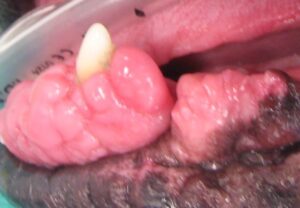23 Feb Gingival Hyperplasia
 Gingival hyperplasia is over-proliferation or thickening of the gingiva or gums. It can occur in one place or throughout the mouth. Boxers, Great Danes, and Collies top the list of breeds presenting for gingival hyperplasia. It is also seen in Mastiffs, Bulldogs, Bassett Hounds, Pit Bull Terriers, Golden Retrievers, and many other breeds. The reaction is most often caused by an inflammatory response to dental plaque and bacteria. In other cases, certain medications like calcium channel blockers (e.g. amlodipine), diphenytoin, and cyclosporine have been linked with hyperplasia.
Gingival hyperplasia is over-proliferation or thickening of the gingiva or gums. It can occur in one place or throughout the mouth. Boxers, Great Danes, and Collies top the list of breeds presenting for gingival hyperplasia. It is also seen in Mastiffs, Bulldogs, Bassett Hounds, Pit Bull Terriers, Golden Retrievers, and many other breeds. The reaction is most often caused by an inflammatory response to dental plaque and bacteria. In other cases, certain medications like calcium channel blockers (e.g. amlodipine), diphenytoin, and cyclosporine have been linked with hyperplasia.
Diagnosis is confirmed through detailed examination, dental x-rays, and biopsy.
Treatment is aimed at decreasing plaque bacteria and discontinuing/decreasing causative medications if possible. Plaque reduction is achieved through a combination of professional periodontal treatment and consistent oral home care; it is essential for successful control. In advanced conditions, surgical resection of gingiva (gingivectomy/gingivoplasty) to restore the gums to a more normal anatomy is indicated. Studies in people have shown improved control with the use of certain medicated toothpastes. Canine patients requiring additional measures to achieve control are sometimes placed on Azithromycin tooth gel.



